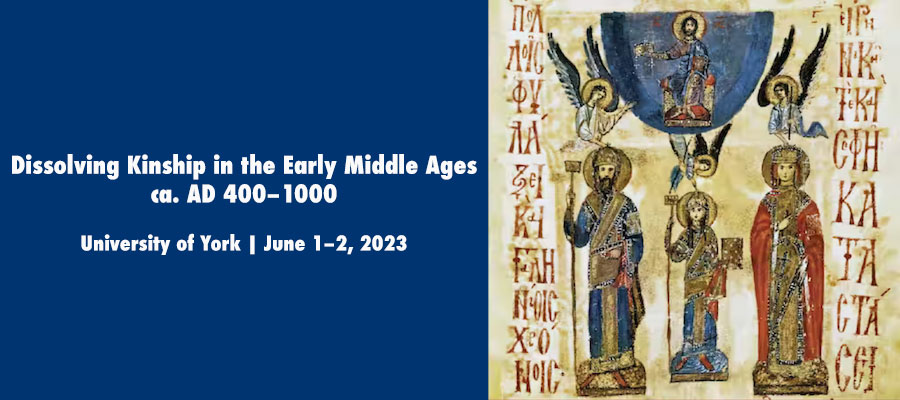Conference Report: The Dissolvement of Kinship Ties in the Early Middle Ages
- Erin Thomas Dailey
- 10 July 2023

He who wishes to remove himself from his kin group (parentilla) should go to court and in the presence of the thunginus or hundredman break four sticks of alderwood over his hear and throw them in four bundles into the four corners of the court and say there that he removes himself from their oathhelping (iuramento), from their inheritance, and from any relationship [with his kin]. Pactus legis Salicae, LX.1, trans. by Katherine Fischer Drew.
Kinship ties were extremely difficult to break in the Early Middle Ages, and when they were severed, it was usually a harmful outcome inflicted upon the weak by the strong. This point recurred throughout a conference held in the beautiful venue of King’s Manor, in York, organised by Becca Grose and Alex Traves and funded by Past & Present: A Journal of Historical Studies and the University of York. Indeed, this passage from Salic law stood out precisely because it was unparalleled in so many ways, as detailed in the keynote address given by Prof. Guy Halsall, who emphasised that Frankish laws addressing social conflict endeavoured, among other objectives, to make litigants stop and think before acting rashly. Alderwood, it turns out, is rather hard to break, and must be dried out for a considerable time first. This passage—which, Prof. Halsall observed, does not begin ‘he who’, but si quis (‘if anyone’), and is not necessarily exclusive of women—should be read as an attempt to arrest the dissolution of kinship as much as to enable it.
How difficult was it? According to the Gospels, Jesus had commanded his followers to love him more than their parents or children (Matthew 10:37–39), but even the monastic movement found it near to impossible to implement this divine teaching, at least in the Carolingian world, as demonstrated by Rachel Stone (and possibly also in early medieval Wales, as argued from a different angle by Caroline Bourne). A similar point recurred for sibling relationships under the Carolingians (Justine Audebrand), for bishops and their wives in Merovingian Gaul (Margot Laprade), for the wives of kings in pre-Norman England (Maria Tranter), and for children given as wards by their parents to allies and rivals anywhere one might look (Alice Hicklin).
What made kinship bonds different from other social relations, which were more easily dissolved? Inheritance goes a long way to providing an answer, as point made in regard to the Rus’ (Tonicha Upham), to the Brahmans of early medieval India (Mekhola Gomes), and to fifth-century North Africa (Becca Grose). As pointed out in the roundtable discussion, chaired by Prof. Catherine Cubitt, kinship bonds were such an ingrained feature of the social fabric that systems of justice depended on it for righting wrongs and compensating victims. For this reason, fratricide &c. were unthinkable acts. (Does the murder pay compensation to himself, as a relative of the victim?) For this reason, fratricide and filicide appeared routinely in apocalyptic rhetoric.
Enslavement came much closer to dissolving kinship ties forever—especially the enslavement of outsiders. As for insiders, Alex Traves explored the issue in penitential literature, and in particular the sale of close kin into slavery, which divided opinions and stoked controversy as regards to kinship obligations. I also attempted to contribute to this discussion by presenting examples in which free men intentionally fathered children from enslaved women in order to given themselves the option to affirm or deny the legitimacy of these children, and how those mechanics worked in different regions of the early medieval Mediterranean world.
For all the talk of dissolving relationships, the conference built many new and exciting ties of scholarship and friendship amongst its participants, thanks to the hard work and masterful organisation efforts of Becca and Alex. It was a joy to attend this conference, and I look forward to whatever future projects they might have up their sleeves. (No sticks of alderwood were required for the participants, of that I am certain.)
Erin Thomas Dailey




